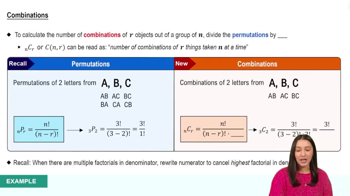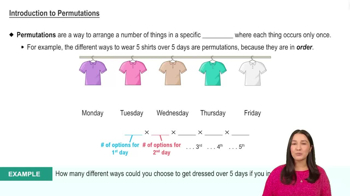How many possible outcomes are there if you roll 5 dice?
Table of contents
- 1. Intro to Stats and Collecting Data1h 14m
- 2. Describing Data with Tables and Graphs1h 55m
- 3. Describing Data Numerically2h 5m
- 4. Probability2h 16m
- 5. Binomial Distribution & Discrete Random Variables3h 6m
- 6. Normal Distribution and Continuous Random Variables2h 11m
- 7. Sampling Distributions & Confidence Intervals: Mean3h 23m
- Sampling Distribution of the Sample Mean and Central Limit Theorem19m
- Distribution of Sample Mean - Excel23m
- Introduction to Confidence Intervals15m
- Confidence Intervals for Population Mean1h 18m
- Determining the Minimum Sample Size Required12m
- Finding Probabilities and T Critical Values - Excel28m
- Confidence Intervals for Population Means - Excel25m
- 8. Sampling Distributions & Confidence Intervals: Proportion1h 12m
- 9. Hypothesis Testing for One Sample3h 29m
- 10. Hypothesis Testing for Two Samples4h 50m
- Two Proportions1h 13m
- Two Proportions Hypothesis Test - Excel28m
- Two Means - Unknown, Unequal Variance1h 3m
- Two Means - Unknown Variances Hypothesis Test - Excel12m
- Two Means - Unknown, Equal Variance15m
- Two Means - Unknown, Equal Variances Hypothesis Test - Excel9m
- Two Means - Known Variance12m
- Two Means - Sigma Known Hypothesis Test - Excel21m
- Two Means - Matched Pairs (Dependent Samples)42m
- Matched Pairs Hypothesis Test - Excel12m
- 11. Correlation1h 6m
- 12. Regression1h 50m
- 13. Chi-Square Tests & Goodness of Fit1h 57m
- 14. ANOVA1h 57m
4. Probability
Fundamental Counting Principle
Problem 4.4.8
Textbook Question
Soccer Shootout In the FIFA Women’s World Cup 2019, a tie at the end of two overtime periods leads to a “shootout” with five kicks taken by each team from the penalty mark. Each kick must be taken by a different player. How many ways can 5 players be selected from the 11 eligible players? For the 5 selected players, how many ways can they be designated as first, second, third, fourth, and fifth?
 Verified step by step guidance
Verified step by step guidance1
Step 1: Recognize that the problem involves two parts: (1) selecting 5 players from 11 eligible players, and (2) arranging the selected 5 players in a specific order (first, second, third, fourth, and fifth).
Step 2: To calculate the number of ways to select 5 players from 11, use the combination formula: , where is the total number of players (11) and is the number of players to be selected (5).
Step 3: Substitute and into the combination formula to compute the number of ways to select 5 players: .
Step 4: To calculate the number of ways to arrange the 5 selected players in a specific order, use the permutation formula: . Substitute and to compute the number of arrangements: .
Step 5: Multiply the results from Step 3 (number of ways to select 5 players) and Step 4 (number of ways to arrange the 5 players) to find the total number of ways to select and arrange the players.
 Verified video answer for a similar problem:
Verified video answer for a similar problem:This video solution was recommended by our tutors as helpful for the problem above
Video duration:
3mPlay a video:
Was this helpful?
Key Concepts
Here are the essential concepts you must grasp in order to answer the question correctly.
Combinations
Combinations refer to the selection of items from a larger set where the order does not matter. In this context, we need to choose 5 players from a pool of 11 eligible players. The formula for combinations is given by C(n, k) = n! / (k!(n-k)!), where n is the total number of items, k is the number of items to choose, and '!' denotes factorial.
Recommended video:

Combinations
Permutations
Permutations involve the arrangement of items where the order does matter. After selecting 5 players, we need to determine the different ways to assign them to specific kicking positions (first, second, etc.). The number of permutations of k items from a set of n is calculated using the formula P(n, k) = n! / (n-k)!, which accounts for the order of selection.
Recommended video:

Introduction to Permutations
Factorial
Factorial is a mathematical operation that multiplies a number by all positive integers less than it. It is denoted by n! and is crucial in both combinations and permutations calculations. For example, 5! = 5 × 4 × 3 × 2 × 1 = 120. Understanding factorials is essential for calculating the total number of ways to select and arrange players in this soccer shootout scenario.
Recommended video:

Combinations

 4:04m
4:04mWatch next
Master Fundamental Counting Principle with a bite sized video explanation from Patrick
Start learningRelated Videos
Related Practice
Multiple Choice
